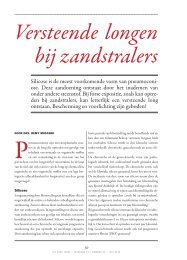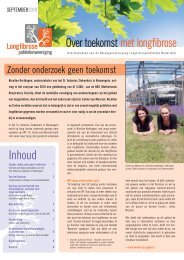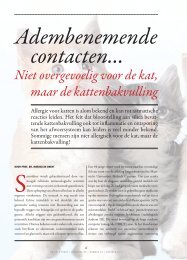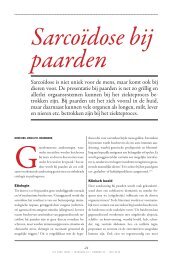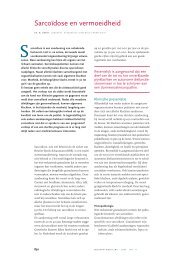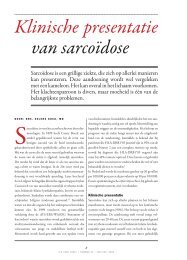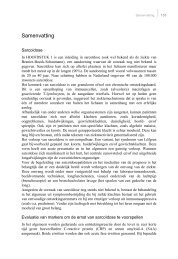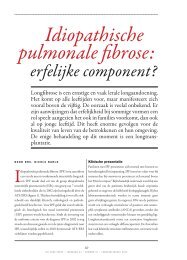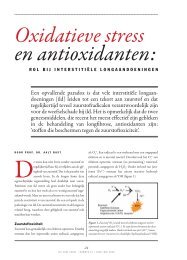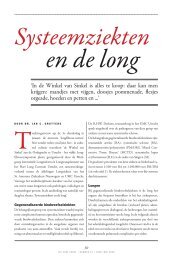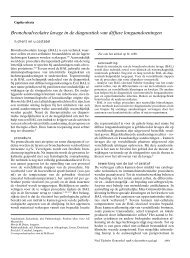Interpretation of bronchoalveolar lavage fluid cytology - ILD care
Interpretation of bronchoalveolar lavage fluid cytology - ILD care
Interpretation of bronchoalveolar lavage fluid cytology - ILD care
You also want an ePaper? Increase the reach of your titles
YUMPU automatically turns print PDFs into web optimized ePapers that Google loves.
<strong>Interpretation</strong> <strong>of</strong> BALF <strong>cytology</strong><br />
present in BALF, e.g. alveolar type II cells [59-61]. An accurate view <strong>of</strong> the patient at work or in the milieu where<br />
respiratory symptoms occur can provide important clues. Dust particles in AMs or elevated asbestos body counts<br />
in BALF and/or the presence <strong>of</strong> birefringent material or inclusion bodies [62], point towards dust or fibre exposure<br />
that may cause illness [8, 62]. Additionally, inhalation challenge with the <strong>of</strong>fending substance in a controlled setting<br />
to reproduce symptoms, can confirm and/or modify the presumable association <strong>of</strong> the respiratory symptoms with<br />
the exposure.<br />
Conclusion<br />
Bronchoalveolar <strong>lavage</strong>, an easily performed and well tolerated procedure, is able to provide cellular<br />
contents, cellular products, and proteins from the lower respiratory tract. When applied according to<br />
standardized protocols, and, considered in the context <strong>of</strong> other information from conventional ancillary<br />
diagnostic tests, BAL appears to be useful in the diagnosis <strong>of</strong> diffuse lung disease. In this respect, BAL<br />
has the advantage <strong>of</strong> avoiding more invasive diagnostic procedures, such as tissue biopsies, in selected<br />
cases. It is likely that BAL will continue to serve as an important procedure for clinical purposes, as well<br />
as a method that facilitates the understanding <strong>of</strong> pathogenesis in processes causing diffuse lung disease.<br />
References<br />
1. Raghu G. Interstitial lung disease: a diagnostic approach. Are CT scan and lung biopsy indicated in every patient? Am J Respir<br />
Crit Care Med 1995; 151: 909-914. [no abstract available]<br />
2. du Bois RM. Diffuse lung disease: a view for the future. Sarcoidosis Vasc Diffuse Lung Dis 1997; 14: 23-30. [no abstract<br />
available]<br />
3. Reynolds HY. Diagnosis and management strategies for diffuse interstitial lung disease. Chest 1998; 113: 192-202. [abstract]<br />
4. Gee JB, Fick RB. Bronchoalveolar <strong>lavage</strong>. Thorax 1980; 35: 1-8. [no abstract available]<br />
5. Reynolds HY. Bronchoalveolar <strong>lavage</strong>. Am Rev Respir Dis 1987; 135: 250-263. [abstract]<br />
6. Walters EH, Gardiner PV. Bronchoalveolar <strong>lavage</strong> as a research tool. Thorax 1991; 46: 613-618. [no abstract available]<br />
7. Baughman RP. Bronchoalveolar <strong>lavage</strong>, 1st ed., St. Louis, Mobsy Year Book, 1992. [no abstract available]<br />
8. Klech H, Hutter C, Costabel U, eds. Clinical guidelines and indications for <strong>bronchoalveolar</strong> <strong>lavage</strong>: report <strong>of</strong> the European Society<br />
<strong>of</strong> Pneumonology Task Group on BAL. Eur Respir Rev 1992; 2: 47-127. [no abstract available]<br />
9. Costabel U. CD4/CD8 ratios in <strong>bronchoalveolar</strong> <strong>lavage</strong> <strong>fluid</strong>: <strong>of</strong> value for diagnosis sarcoidosis? Eur Respir J 1997; 10: 2699-<br />
2700. [no abstract available]<br />
10. Chang HY, Chen CW, Chen CY, et al. Successful treatment <strong>of</strong> diffuse lipoid pneumonitis with whole lung <strong>lavage</strong>. Thorax 1993;<br />
48: 947-948. [abstract]<br />
11. Daniele RP, Elias JA, Epstein PE, Rossman MD. Bronchoalveolar <strong>lavage</strong>: role in the pathogenesis, diagnosis, and management<br />
<strong>of</strong> interstitial lung disease. Ann Intern Med 1985; 102: 93-108. [abstract]<br />
12. The BAL Cooperative Group Steering Committee. Bronchoalveolar <strong>lavage</strong> constituents in healthy individuals, idiopathic<br />
pulmonary fibrosis, and selected comparison groups. Am Rev Respir Dis 141; 1990: 169-202. [abstract]<br />
13. Klech H, Pohl W. Technical recommendations and guidelines for <strong>bronchoalveolar</strong> <strong>lavage</strong> (BAL). Eur Respir J 1989; 2: 561-585.<br />
[abstract]<br />
14. Drent M, Nierop van MAMF, Gerritsen FA, et al. Computer program using BALF analysis results as diagnostic tool in interstitial<br />
lung diseases. Am J Respir Crit Care Med 1996; 153: 736-741. [abstract] [full paper]<br />
15. Drent M, Jacobs JA, Vries de J,et al. Does the cellular <strong>bronchoalveolar</strong> <strong>lavage</strong> <strong>fluid</strong> pr<strong>of</strong>ile reflect the severity <strong>of</strong> sarcoidosis?<br />
Eur Respir J 1999; 13: 1338-1344. [abstract] [full text PDF-file]<br />
16. Ward K, O'Conner C, Odlum C, Fitzgerald XM. Prognostic value <strong>of</strong> <strong>bronchoalveolar</strong> <strong>lavage</strong> in sarcoidosis: the critical influence<br />
<strong>of</strong> disease presentation. Thorax 1989; 44: 6-12. [abstract]<br />
17. Verstraeten A, Demedts M, Verwilghen J, et al. Predictive value <strong>of</strong> <strong>bronchoalveolar</strong> <strong>lavage</strong> in pulmonary sarcoidosis. Chest 1990;<br />
98: 560-567. [abstract]<br />
18. Fireman E, Vardinon N, Burke, et al. Predictive value <strong>of</strong> response to treatment <strong>of</strong> T-lymphocyte subpopulations in idiopathic<br />
pulmonary fibrosis. Eur Respir J 1998; 11: 706-711. [abstract]<br />
19. Baughman RP, Haslam PL, eds. Guidelines for measurement <strong>of</strong> acellular components and recommendations for standardisation<br />
<strong>of</strong> <strong>bronchoalveolar</strong> <strong>lavage</strong> (BAL). Eur Respir Rev 1999; 9: 66. [abstract]<br />
20. Fijter de JW, Hoeven van der JG, Eggelmeijer F, Meinders AE. Sepsis syndrome and death after <strong>bronchoalveolar</strong> <strong>lavage</strong>. Chest<br />
1993: 104: 1296-1297. [no abstract available]<br />
21. Djamin RS, Drent M, Scheurs AJM, et al. Diagnosis <strong>of</strong> Pneumocystis carinii pneumonia in HIV-positive patients. Bronchoalveolar<br />
<strong>lavage</strong> versus bronchial brushing. Acta Cytol 1998; 42:933-938. [abstract]<br />
22. Marquette CH, Copin M-C, Wallet F, et al. Diagnostic tests for pneumonia in ventilated patients: prospective evaluation <strong>of</strong><br />
diagnostic accuracy using histology as a diagnostic gold standard. Am J Respir Crit Care Med 1995; 151: 1878-1888. [abstract]<br />
23. De Brauwer EIGB, Jacobs JA, Nieman F, et al. Test characteristics <strong>of</strong> Acridine Orange, Gram and May-Grünwald Giemsa stains<br />
for enumeration <strong>of</strong> intracellular organisms in <strong>bronchoalveolar</strong> <strong>lavage</strong> <strong>fluid</strong>. J Clin Microbiol 1999; 37: 427-497. [abstract] [full<br />
paper]<br />
24. Gerbeaux P, Ledoray V, Boussuges A, et al. Diagnosis <strong>of</strong> nosocomial pneumonia in mechanically ventilated patients:<br />
repeatability <strong>of</strong> the <strong>bronchoalveolar</strong> <strong>lavage</strong>. Am J Respir Crit Care Med 1998; 157: 76-80. [abstract]<br />
25. Jacobs JA, Brauwer de EIGB, Ramsay G, et al. Detection <strong>of</strong> non-infectious conditions mimicking pneumonia in the intensive <strong>care</strong><br />
setting: usefulness <strong>of</strong> BAL <strong>fluid</strong> <strong>cytology</strong>. Respir Med 1999; 93: 571-578. [abstract]<br />
Bronchoalveolar <strong>lavage</strong>. Drent et al. Eur Respir Mon 2000. 7



